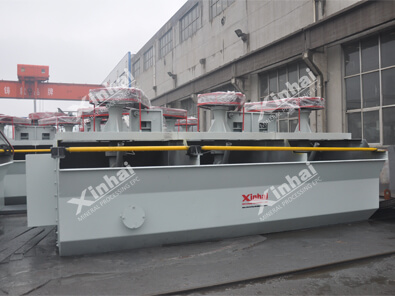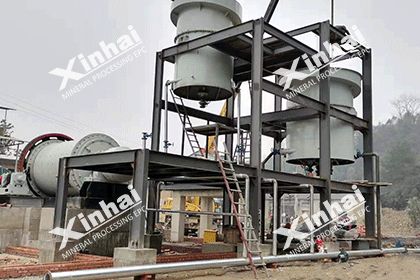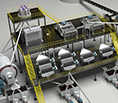Lithium Mineral Processing Solutions: Optimizing Resource Recovery
 Essow
Essow
 Mar 29, 2023
Mar 29, 2023
 2045
2045
If you want to know more details about equipment, solutions, etc, please click the button below for free consultation, or leave your requirements!
The demand for lithium-ion batteries has increased significantly in recent years due to the growing popularity of electric vehicles and renewable energy storage systems. Lithium is a critical component of these batteries, and the demand for lithium is expected to continue to grow in the coming years. Lithium extraction and processing play a crucial role in meeting this demand. Lithium mineral processing involves the physical and chemical transformation of raw ore into a final product that is saleable. This process is complex and requires the use of various technologies and equipment to optimize resource recovery.

(Lithium Ore)
01What are some of the most common challenges faced by the lithium industry?
BackThe lithium industry faces a number of challenges that can impact the efficiency and profitability of lithium production. Some of the most common challenges include:
1. Fluctuating demand: The demand for lithium can be volatile and is subject to fluctuations due to changes in global economic conditions, government policies, and the adoption rate of electric vehicles and renewable energy storage systems.
2. Geographical constraints: Lithium resources are concentrated in a few countries, such as Chile, Argentina, Australia, and China. This can create logistical challenges in terms of transportation and supply chain management.
3. Environmental concerns: Lithium mining and processing can have significant environmental impacts, including water and air pollution, land degradation, and greenhouse gas emissions. Companies must comply with environmental regulations and implement sustainable practices to mitigate these impacts.
4. Technical complexity: Lithium extraction and processing involve complex chemical and physical processes, which require specialized knowledge and expertise. Companies must invest in research and development to develop new technologies and optimize existing ones.
5. Cost pressures: Lithium production can be expensive due to the high capital costs of equipment and infrastructure, as well as the costs of labor, energy, and raw materials. Companies must manage costs effectively to maintain profitability.
6. Supply chain risk: The lithium supply chain is complex and involves multiple stakeholders, including miners, processors, manufacturers, and end-users. Companies must manage supply chain risks, such as price volatility, quality issues, and geopolitical risks.
Overall, the lithium industry faces a range of challenges that require innovative solutions and a long-term perspective. Companies must be proactive in addressing these challenges to ensure sustainable growth and profitability.
02What are some of the new technologies being developed for lithium extraction and processing?
BackThere are several new technologies being developed for lithium extraction and processing that aim to improve the efficiency, sustainability, and cost-effectiveness of the process. Some of these technologies include:
1. Direct lithium extraction: This technology involves extracting lithium from brines without the need for evaporation ponds, which can be expensive and environmentally damaging. Direct lithium extraction uses selective membranes, ion exchange resins, or other separation techniques to extract lithium from brine.
2. Geothermal extraction: This technology involves extracting lithium from geothermal brines, which are hot, saline waters found in geothermal reservoirs. Geothermal extraction can be more sustainable than traditional brine extraction methods and can also produce renewable energy.
3. Lithium clay processing: This technology involves extracting lithium from clay deposits, which are found in several countries, including the United States, Canada, and Mexico. Lithium clay processing uses acid leaching techniques to extract lithium from clay.
4. Innovative lithium recovery methods: There are several innovative technologies being developed to recover lithium from unconventional sources, such as oilfield brines, wastewater, and seawater. These methods include adsorption, precipitation, and membrane filtration.
5. Electrification and automation: Electrification and automation technologies are being developed to reduce energy consumption and improve the efficiency of lithium processing. These technologies include electric vehicles, renewable energy systems, and autonomous equipment.
Overall, new technologies are being developed to address the challenges facing the lithium industry and to improve the efficiency and sustainability of lithium extraction and processing. These technologies have the potential to transform the lithium industry and to support the growth of the electric vehicle and renewable energy markets.
If you want to know more about traditional lithium extraction method, please click the link to check.

03How do these new technologies compare to traditional lithium extraction methods?
BackNew technologies for lithium extraction and processing have the potential to be more efficient, sustainable, and cost-effective than traditional methods. Here are some of the key differences between new and traditional methods:
1. Efficiency: New technologies for lithium extraction and processing can be more efficient than traditional methods, which can result in higher resource recovery and lower operating costs. For example, direct lithium extraction can extract lithium from brines more quickly and with less water than traditional evaporation methods.
2. Sustainability: New technologies for lithium extraction and processing can be more sustainable than traditional methods, which can be environmentally damaging and require significant amounts of water and energy. For example, geothermal extraction can produce renewable energy while extracting lithium from geothermal brines.
3. Cost-effectiveness: New technologies for lithium extraction and processing can be more cost-effective than traditional methods, which can be expensive due to the high capital costs of equipment and infrastructure, as well as the costs of labor, energy, and raw materials. For example, lithium clay processing can be less expensive than traditional brine extraction methods.
4. Scalability: New technologies for lithium extraction and processing can be more scalable than traditional methods, which may be limited by the availability of resources or infrastructure. For example, innovative lithium recovery methods can extract lithium from unconventional sources, such as oilfield brines or seawater, which can expand the available supply of lithium.
Overall, new technologies for lithium extraction and processing are designed to address the challenges facing the lithium industry and to improve the efficiency, sustainability, and cost-effectiveness of the process. While traditional methods have been used for many years, new technologies offer the potential for significant improvements in resource recovery, environmental impact, and economics.
If you want to know more about Lithium processing machines, please click the link to check.
04How do the costs of lithium extraction and processing compare between traditional and new methods?
BackThe costs of lithium extraction and processing can vary widely depending on a range of factors, including the type of deposit, the extraction method, the processing technology, and the scale of operation. However, new methods for lithium extraction and processing have the potential to be more cost-effective than traditional methods in certain circumstances. Here are some of the ways that the costs of traditional and new methods can compare:
1. Capital costs: Traditional lithium extraction methods, such as brine evaporation, can require significant capital investment in infrastructure, such as evaporation ponds, pipelines, and processing plants. New methods, such as direct lithium extraction or geothermal extraction, may require less infrastructure investment, which can reduce capital costs.
2. Operating costs: Traditional lithium extraction and processing methods can be energy-intensive and can require significant amounts of water and chemicals, which can increase operating costs. New methods, such as direct lithium extraction or lithium clay processing, may be more energy-efficient and can use less water and chemicals, which can reduce operating costs.
3. Resource recovery: Traditional lithium extraction methods, such as brine evaporation, can have lower resource recovery rates, which can reduce the overall profitability of the operation. New methods, such as direct lithium extraction or innovative lithium recovery methods, can have higher resource recovery rates, which can increase profitability.
4. Environmental costs: Traditional lithium extraction and processing methods can have significant environmental impacts, such as water and air pollution, land degradation, and greenhouse gas emissions, which can increase regulatory and remediation costs. New methods, such as geothermal extraction or lithium clay processing, can be more sustainable and can reduce environmental costs.
Overall, the costs of lithium extraction and processing can be highly variable depending on the specific circumstances of each project. While new methods have the potential to be more cost-effective than traditional methods in certain circumstances, it is important to conduct a thorough economic analysis to determine the most appropriate method for each project.
05How do the environmental costs of traditional and new methods compare?
BackThe environmental costs of traditional and new methods for lithium extraction and processing can vary widely depending on a range of factors, including the type of deposit, the extraction method, the processing technology, and the scale of operation. However, in general, new methods for lithium extraction and processing have the potential to be more sustainable and have lower environmental costs than traditional methods. Here are some of the ways that the environmental costs of traditional and new methods can compare:
1. Water use: Traditional lithium extraction methods, such as brine evaporation, can require significant amounts of water, which can strain local water resources and have negative impacts on aquatic ecosystems. New methods, such as direct lithium extraction or lithium clay processing, can use less water and can be more water-efficient.
2. Chemical use: Traditional lithium extraction and processing methods can require the use of chemicals, such as acid or alkali, which can have negative impacts on soil and water quality. New methods, such as direct lithium extraction or geothermal extraction, can use fewer chemicals, reducing the environmental impact.
3. Land use: Traditional lithium extraction methods, such as brine evaporation, can require significant amounts of land for the construction of evaporation ponds, which can have negative impacts on local ecosystems and biodiversity. New methods, such as direct lithium extraction or geothermal extraction, may require less land, reducing the environmental impact.
4. Greenhouse gas emissions: Traditional lithium extraction and processing methods can generate significant greenhouse gas emissions, which contribute to climate change. New methods, such as geothermal extraction or renewable energy-powered processing, can reduce greenhouse gas emissions and improve the sustainability of the process.
Overall, new methods for lithium extraction and processing have the potential to reduce the environmental costs of the process and make it more sustainable. While traditional methods have been used for many years, the increasing demand for lithium and the need for sustainable practices are driving the development of new methods that can address environmental concerns.
06What are the main challenges in implementing new methods for lithium extraction?
BackThere are several challenges in implementing new methods for lithium extraction, including:
1. Technical feasibility: New methods for lithium extraction and processing are often in the early stages of development and may not yet be commercially viable. Companies must invest in research and development to determine the technical feasibility of new methods and to optimize the process.
2. Capital investment: Implementing new methods for lithium extraction and processing may require significant capital investment in infrastructure, equipment, and technology. Companies must evaluate the cost-benefit of adopting new methods and determine the most appropriate financing strategies.
3. Regulatory requirements: New methods for lithium extraction and processing may require regulatory approval, which can be a lengthy and complex process. Companies must navigate the regulatory landscape and comply with environmental and safety regulations.
4. Supply chain integration: Implementing new methods for lithium extraction and processing may require changes to the supply chain, including the sourcing of raw materials and the distribution of the final product. Companies must work with their partners and suppliers to integrate new methods into the supply chain.
5. Human resources: Implementing new methods for lithium extraction and processing may require specialized knowledge and expertise, which may not be readily available. Companies must invest in training and development to ensure that their personnel are equipped with the necessary skills and knowledge.
Overall, implementing new methods for lithium extraction and processing requires careful planning, investment, and collaboration. Companies must address the technical, financial, regulatory, and human resource challenges to successfully adopt new methods and improve the sustainability and efficiency of the process.
07Conclusion
BackThe lithium industry is facing increasing demand for its products due to the growing popularity of electric vehicles and renewable energy storage systems. While traditional methods for lithium extraction and processing have been used for many years, new technologies are being developed to address the challenges facing the industry and to improve the efficiency, sustainability, and cost-effectiveness of the process.
At Lithium Mineral Processing Solutions, we are committed to providing our clients with innovative solutions that optimize resource recovery and support the growth of the industry. Our team of experts has extensive experience in lithium mineral processing and can provide tailored solutions to meet the unique needs of each project.
We believe that the future of the lithium industry lies in the adoption of sustainable and efficient technologies that can address the environmental and economic challenges facing the industry. By investing in research and development, implementing new methods, and collaborating with our partners and clients, we can help to create a more sustainable and prosperous future for the lithium industry.
Contact us today to learn more about how we can help optimize your lithium mineral processing operations and support your sustainability goals.
 +86 183 3575 8886
+86 183 3575 8886 pinklaurabao@gmail.com
pinklaurabao@gmail.com




 Message
Message Chat Now
Chat Now



















